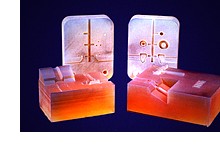|
Frantz Tool and Design
 Achieving Surgical Precision with 3D Keltool
Achieving Surgical Precision with 3D Keltool
Eye
surgery is an exacting science. A surgeon must execute highly precise procedures to ensure success. So, too, is the 3D Keltool process. Exact tolerances must be met, fine details reproduced, and quality production parts created. That's why when Frantz Medical Development, Ltd., Mentor, Ohio, an FDA-registered medical device manufacturer, and its plastic injection molding division, Frantz Tool and Design, was approached to design a Disposable Automatic Corneal Shaper (DACS) for a new refractive surgical procedure for correcting vision, called LASIK, they turned to 3D Keltool.
A Low Cost Alternative
Invented by an eye surgeon in Bogota, Colombia, DACS was conceived as a low cost, disposable alternative to the re-usable stainless steel corneal shaper already in use. During the LASIK procedure, DACS slices a flap of the corneal surface, typically between 130 to 150 microns (0.005 to 0.006 inches). The flap is pulled back to allow a laser to make micro-adjustments to the structure of the cornea. After laser treatment, the flap is laid back into place and re-adheres itself to the base of the cornea, thus eliminating the need for sutures. Because the re-usable devices must be reset for each patient, they increase the risk of physician error. The DACS, however, can be manufactured with a fixed slice thickness, leaving no chance for miscalculation.
The
product development cycle posed several challenges for the Frantz design team. The material selected needed to be tested for its cosmetic appearance. It had to be optically clear and easily sterilized. And, most important, it needed to hold the final dimensions and tolerances between the cutting edge and the cutting surfaces in assembly. Since the complex part contained numerous compound curves, Mike Litscher, Vice President of Manufacturing Operations for Frantz Medical, knew from past experience that 3D Keltool could quickly and effectively do the job, holding tolerances of +/- 0.005 inches.
 Minimize Design Delays
Minimize Design Delays
Simply put, 3D Keltool offered Frantz a hedge against program slips. While engineering was finalizing the design, 3D Keltool enabled the project to continue into functional testing, thus minimizing the impact of various design delays. "By using 3D Keltool we will achieve market introduction on time, even with the slips in design we have encountered along the production path," says Litscher.
Another challenge the project faced was demonstrating the feasibility of making the device out of plastic. Since original design tolerances were not possible using conventional tooling, the design team needed a way to assemble and inspect the final blade orientation. Using 3D Keltool cores and cavities, Frantz was able to test possible end-use plastic materials for the part. These plastic parts were subjected to radiation sterilization by gamma rays, and then evaluated from a color and clarity standpoint.
After designing the mold inserts in Pro/ENGINEER, Frantz then transferred the files to the Tooling Center which produced the SLA mold inserts, hand finished them, and sent them to Minneapolis for production of the 3D Keltool core and cavity inserts. The inserts were created in only two weeks and then sent back to Frantz. After parts were molded, the most critical sub-assembly of the DACS, with respect to blade alignment, was assembled and given to one of the world's most renowned eye surgeons for inspection. Once approved, complete working prototypes will be produced for actual clinical trials.
Looking to the Future
Future challenges to successful completion of the project include issues of modification. With almost 20 different components comprising the total DACS assembly, is it possible to modify the 3D Keltool inserts to produce fully functional prototype parts that are acceptable for clinical trials? Will the 3D Keltool process hold the extremely tight tolerances necessary for full assembly of the device?
These questions remain unanswered, but Litscher is confident that 3D Keltool can hold up to the demanding tolerances necessary for final assembly. With some tweaking of the mold, Frantz is determined to hold tolerances of +/- 0.001 inches, much tighter than the +/- 0.005 inches that 3D Keltool normally provides. Litscher declares, "We have been pleased with the tolerances afforded by the 3D Keltool process to date, and look forward to testing the limits during production of the working prototypes." If Frantz is indeed successful, 3D Keltool will have proven once again that it is the only rapid tooling process able to deliver this exceptional level of accuracy.
|



